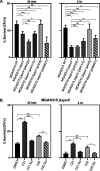The Streptococcus pyogenes signaling peptide SpoV regulates streptolysin O and enhances survival in murine blood
- PMID: 33722844
- PMCID: PMC8117530
- DOI: 10.1128/JB.00586-20
The Streptococcus pyogenes signaling peptide SpoV regulates streptolysin O and enhances survival in murine blood
Abstract
Streptococcus pyogenes (Group A Streptococcus, GAS) is a human pathogen that causes a wide range of diseases. For successful colonization within a variety of host niches, GAS must sense and respond to environmental changes. Intercellular communication mediated by peptides is one way GAS coordinates gene expression in response to diverse environmental stressors, which enhances bacterial survival and contributes to virulence. Using peptidomics we identified SpoV (
Copyright © 2021 Herrera et al.
Figures






Similar articles
-
Signaling Peptide SpoV Is Essential for Streptococcus pyogenes Virulence, and Prophylaxis with Anti-SpoV Decreases Disease Severity.Microorganisms. 2021 Nov 10;9(11):2321. doi: 10.3390/microorganisms9112321. Microorganisms. 2021. PMID: 34835447 Free PMC article.
-
Intracellular Group A Streptococcus Induces Golgi Fragmentation To Impair Host Defenses through Streptolysin O and NAD-Glycohydrolase.mBio. 2021 Feb 9;12(1):e01974-20. doi: 10.1128/mBio.01974-20. mBio. 2021. PMID: 33563838 Free PMC article.
-
Binding of NAD+-Glycohydrolase to Streptolysin O Stabilizes Both Toxins and Promotes Virulence of Group A Streptococcus.mBio. 2017 Sep 12;8(5):e01382-17. doi: 10.1128/mBio.01382-17. mBio. 2017. PMID: 28900022 Free PMC article.
-
Secreted Virulence Factors of Streptococcus pyogenes.2022 Jul 28 [updated 2022 Nov 19]. In: Ferretti JJ, Stevens DL, Fischetti VA, editors. Streptococcus pyogenes: Basic Biology to Clinical Manifestations [Internet]. 2nd edition. Oklahoma City (OK): University of Oklahoma Health Sciences Center; 2022 Oct 8. Chapter 13. 2022 Jul 28 [updated 2022 Nov 19]. In: Ferretti JJ, Stevens DL, Fischetti VA, editors. Streptococcus pyogenes: Basic Biology to Clinical Manifestations [Internet]. 2nd edition. Oklahoma City (OK): University of Oklahoma Health Sciences Center; 2022 Oct 8. Chapter 13. PMID: 36479759 Free Books & Documents. Review.
-
Secreted Extracellular Virulence Factors.2016 Feb 10 [updated 2016 Mar 25]. In: Ferretti JJ, Stevens DL, Fischetti VA, editors. Streptococcus pyogenes: Basic Biology to Clinical Manifestations [Internet]. Oklahoma City (OK): University of Oklahoma Health Sciences Center; 2016–. 2016 Feb 10 [updated 2016 Mar 25]. In: Ferretti JJ, Stevens DL, Fischetti VA, editors. Streptococcus pyogenes: Basic Biology to Clinical Manifestations [Internet]. Oklahoma City (OK): University of Oklahoma Health Sciences Center; 2016–. PMID: 26866214 Free Books & Documents. Review.
Cited by
-
Signaling Peptide SpoV Is Essential for Streptococcus pyogenes Virulence, and Prophylaxis with Anti-SpoV Decreases Disease Severity.Microorganisms. 2021 Nov 10;9(11):2321. doi: 10.3390/microorganisms9112321. Microorganisms. 2021. PMID: 34835447 Free PMC article.
-
CovS inactivation reduces CovR promoter binding at diverse virulence factor encoding genes in group A Streptococcus.PLoS Pathog. 2022 Feb 18;18(2):e1010341. doi: 10.1371/journal.ppat.1010341. eCollection 2022 Feb. PLoS Pathog. 2022. PMID: 35180278 Free PMC article.
References
-
- Vega LA, Malke H, McIver KS. 2016. Virulence-related transcriptional regulators of Streptococcus pyogenes. In Ferretti JJ, Stevens DL, Fischetti VA (ed), Streptococcus pyogenes: basic biology to clinical manifestations. University of Oklahoma Health Sciences Center, Oklahoma City, OK. - PubMed
Grants and funding
LinkOut - more resources
Full Text Sources
Other Literature Sources

